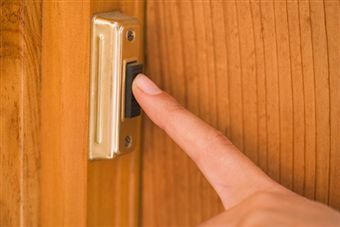
It's hard to manage a house, by chance a big one, with a dysfunctional doorbell affixed on the front or back door. Well, how about fixing the doorbell buzz, so that the idea of a doorbell being present at your doorstep makes sense. To learn how to repair or wire a doorbell isn't as intimidating as you may think. You can exchange an old doorbell for a new one, by purchasing the appropriate doorbell buttons and installation kit available for the same. They are just few simple tools and you are good to go. Then, in no time you will again listen to the ding-dong buzzing around in your home!
Tips for Doorbell Wiring Troubleshooting
- A normal residential door bell's voltage is very low ranging from 16-24 volts, except for the line side of transformer.
- Also do not follow the colors of the wires because they can be different. They are distinctively 18 gauge wires.
- Check the transformer, the voltage tester should signal 16, 18 or 24 volts at both the transformer terminals. If there is voltage out there, check the chime of the doorbell.
- Send your partner to the doorbell to hold the button, meanwhile you can check for the voltage between the front screw and the common terminal.
- If a correct voltage is received 16, 18 or 24 volts this indicates the chime is buggered.
- Follow the same procedure for rear button and screw too.
- If the voltage doesn't flow through rear and front buttons when they are pressed, check for the conditions of the buttons itself.
- If the voltage arrives at the chime unit, that's when you know you have a spoiled button to replace.
Layout of a Doorbell
Well, the above mentioned were some basic troubleshooting tips and techniques one must keep in mind for a job like doorbell repair. Doorbell, being a closed circuit system, consists of a chime generator, a power transformer and an actual doorbell switch. In technical terms, it's called SPST (Single Pole Single Throw) switch which temporarily closes the circuit in the system. Such a switching action simply provides the power generated from the transformer to the chime unit in the time of action when the doorbell is lowered down to a limit. Just to remember in short a doorbell functions as a simple switching circuit. I am hoping this explanation is not getting too technical for you to comprehend, but the basic idea of a doorbell wiring would only be understood if one understands the working of this entire circuit by considering a schematic layout to work with.
Method for Wiring a Doorbell
Firstly, you will need to work on two wiring tasks. Now, the chime part which has a power source of 110/120 volts needs to be wired to the switches in order to receive power from a transformer to a chime box. Doorbell wiring, in short, is wiring the chime into your home's power supply and also wiring the switch(es) into a transformer coming out from the chime.
Required Materials
- Doorbell System
- Wire Strippers
- Screwdriver
- 18- gauge Cable
Wiring Steps
Step #1: In the first step, disconnect the main power supply going to the doorbell to maintain electrical safety in your home. Then, slowly dismount the doorbell screws and accessories and carefully pull the switch button away from the wall.
Step #2: Make sure you also disconnect the wires from the old switch button.
Step #3: If you fear the wires will slip back into the cavity of the wall, tape them up with wire strippers against the wall. Also, try to hook all the wires to the terminals of the screw on the switch.
Step #4: Now you will have to shift your work to the place where the old chime unit is. Take off the cover plate and find all the screws that fasten the unit, unscrew 'em and take out the entire unit slowly.
Step #5: Note, before removing the wires, you mark their correct connections and locations so as to make it easier while replacing the new kit. You will find wires at the chime unit too, tape 'em the same way as you did in step #3.
Step #6: Now it's time to attach the wires back to the base unit of the new chime unit you have in your hand for replacement.
Step #7: With this progress, mount the new chime unit onto the wall carefully using the accessories like screws and stuff the new kit has with it.
Step #8: Also, check for the measurement of the old unit and the new. If they don't match in size, mark new holes with a pencil and drill new holes to fit the new chime.
Step #9: The markings which you have created for the wires use them to connect them properly to the correct terminal of the new chime.
Step #10: Once that's done, put the cover plate back in its place and check the entire doorbell connection system for its working condition. If the doorbell rings or chimes, whatever, your wiring job is done here!
In the technical or electronic field, the job of a wiring is the most simplest and safest because it uses very low voltage wiring technique to handle the components. Another simple process you can undertake is following a simplified diagram, where in every wire connection and directions would be shown in a straightforward manner.





